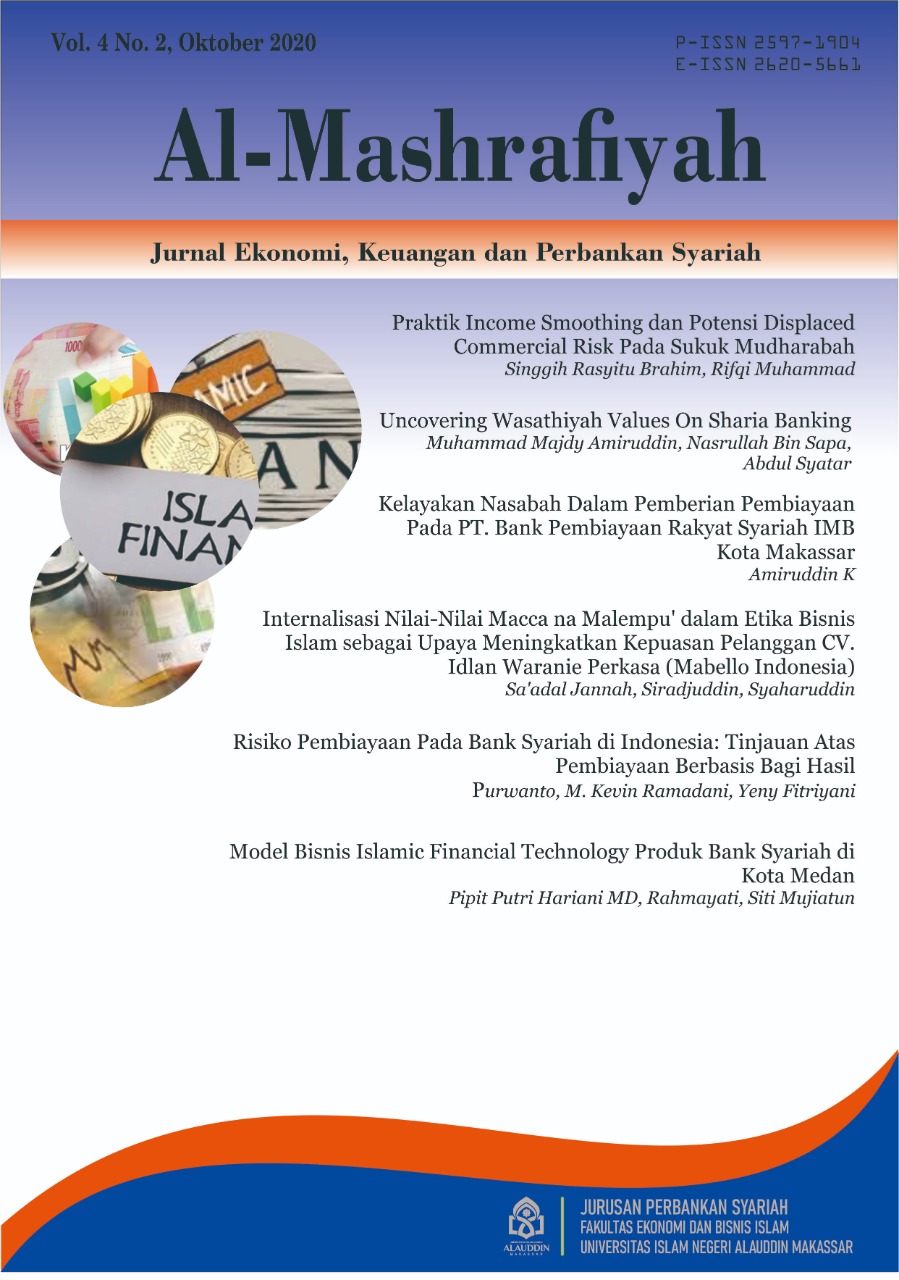Model Bisnis Islamic Financial Technology Produk Bank Syariah di Kota Medan
Abstract
This study aims to provide a business model of financing processes in Islamic banks through the financial technology model. By outlining the process that is practiced at four Islamic banks, namely PT. Bank Muamalat, PT. BRISyariah, PT. Bank Aceh, and PT. North Sumatra Bank. So as to produce a model in the implementation of business financing products. This research method uses a qualitative descriptive approach through the stages of determining problems, interviews, and conclusions. Based on the financing procedures of the four Islamic banks, it was analyzed that PT. Bank Aceh and PT. Bank of North Sumatra still applies a manual system. PT. Bank Muamalat and PT. BRISyariah has implemented a combination of technology and manual processes, but PT. BRISyariah is more comprehensive than PT. Bank Muamalat. The results of the study prove that the fintech business model in the financing process at Islamic banks accelerates the financing process for customers.References
Accenture. 2015. The Future of Fintech and Banking. Accenture, 1–12. https://www.accenture.com/_acnmedia/accenture/conversion-assets/dotcom/documents/global/pdf/dualpub_11/accenture-future-fintech-banking.pdf
Amalia, F. 2016. the Fintech Book: the Financial Technology Handbook for Investors, Entrepreneurs and Visionaries. Journal of Indonesian Economy and Business, 31(3), 345. https://doi.org/10.22146/jieb.23554
Anikina, I. D., Gukova, A. V., Golodova, A. A., & Chekalkina, A. A. 2016. Methodological aspects of prioritization of financial tools for stimulation of innovative activities. European Research Studies Journal, 19(2 Special Issue), 100–112. https://doi.org/10.35808/ersj/525
Chishti, S., & Barberis, J. 2016. The Fintech Book. The Financial Technology Handbook for Investors, Entreprenuers and Visonaries. Chichester, West Sussex, United Kingdom: Wiley & Sons Ltd.
Dodgson, M., Gann, D., Wladawsky-Berger, I., Sultan, N., & George, G. 2015. Managing digital money. Academy of Management Journal, 58(2), 325–333. https://doi.org/10.5465/amj.2015.4002
Faizal, B., & Rahim, A. 2016. Fintech Pitch for Islamic Bank : Three New Areas of Services. September, 1–7. https://islamicbankers.files.wordpress.com/2017/02/fintech-pitch-for-islamic-banking1.pdf
Harrison, R., Jaumandreu, J., Mairesse, J., & Peters, B. 2014. Does innovation stimulate employment? A firm-level analysis using comparable micro-data from four European countries. International Journal of Industrial Organization, 35(1), 29–43. https://doi.org/10.1016/j.ijindorg.2014.06.001
Hes, A., & Jílková, P. 2016. Position of low-cost banks on the financial market in the Czech Republic. European Research Studies Journal, 19(4), 42–52. https://doi.org/10.35808/ersj/579
Kholil, Syukur. 2006 Metodologi Penelitian, cet. Ke-1 Bandung: Cipta Pustaka Media
Mansor, N., Shariff, A., & Abdul Manap, N. R. 2012. Determinants of Awareness on Islamic Financial Institution E-Banking among Malaysian SMEs. International Journal of Business and Social Science, 3(5), 93–101. https://ijbssnet.com/journals/Vol_3_No_5_March_2012/10.pdf
Muia, A. M. (2013). the Relationship Between Financial Innovation and Growth in Profitability of Islamic Banking in Kenya By a Research Project Report Submitted in Partial Fulfillment of the Requirements for the Award of Master of Business Administration Degree ,. https://pdfs.semanticscholar.org/192c/3e27b9190efc79864a4288b5f67cd6d97e01.pdf
Nawawi, Hadari, & Martini, M. 1996. Penelitian Terpadu, Yogyakarta: Gajah Mada University Press
Nsouli, S. M., & Fullenkamp, C. (2004). Six Puzzles in Electronic Money and Banking. IMF Working Papers, 04(19), 1. https://doi.org/10.5089/9781451843774.001
Pejkovska, M. (2018). Potential negative effects of Fintech on the finan- cial services sector Examples from the European Union , India and the United States of America. https://core.ac.uk/download/pdf/161429545.pdf
Raman, M., Stephenaus, R., Alam, N., & Kuppusamy, M. 2008. E-service quality and Uptake of Internet banking. Journal of Internet Banking and Commerce, 13(2), 1–19. http://www.icommercecentral.com/open-access/information-technology-in-malaysia-eservice-quality-and-uptake-of-internet-banking.pdf
Rothwell, R. 1994. Towards the Fifth-generation Innovation Process. International Marketing Review, 11(1), 7–31. https://doi.org/10.1108/02651339410057491
Ruslan, Rosyadi. 2004. Metode Penelitian Publlik Relation dan Komunikasi, Jakarta : Raja Grafindo Persada
Saksonova, S., & Kuzmina-Merlino, I. 2017. Fintech as financial innovation - The possibilities and problems of implementation. European Research Studies Journal, 20(3), 961–973. https://doi.org/10.35808/ersj/757
Setyawati, I., Suroso, S., Suryanto, T., & Nurjannah, D. S. 2017. Does financial performance of Islamic banking is better? Panel data estimation. European Research Studies Journal, 20(2), 592–606. https://doi.org/10.35808/ersj/661
Vlasov, A. V. 2017. The Evolution of E-Money. XX(1), 215–224. https://econpapers.repec.org/RePEc:ers:journl:v:xx:y:2017:i:1:p
Vovchenko, N. G., Tishchenko, E. N., Epifanova, T. V., & Gontmacher, M. B. 2017. Electronic currency: The potential risks to national security and methods to minimize them. European Research Studies Journal, 20(1), 36–48. https://www.ersj.eu/repec/ers/papers/17_1_p3.pdf


